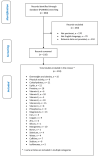Nutrition, Physical Activity, and Dietary Supplementation to Prevent Bone Mineral Density Loss: A Food Pyramid
- PMID: 35010952
- PMCID: PMC8746518
- DOI: 10.3390/nu14010074
Nutrition, Physical Activity, and Dietary Supplementation to Prevent Bone Mineral Density Loss: A Food Pyramid
Abstract
Bone is a nutritionally modulated tissue. Given this background, aim of this review is to evaluate the latest data regarding ideal dietary approach in order to reduce bone mineral density loss and to construct a food pyramid that allows osteopenia/osteoporosis patients to easily figure out what to eat. The pyramid shows that carbohydrates should be consumed every day (3 portions of whole grains), together with fruits and vegetables (5 portions; orange-colored fruits and vegetables and green leafy vegetables are to be preferred), light yogurt (125 mL), skim milk (200 mL,) extra virgin olive oil (almost 20 mg/day), and calcium water (almost 1 l/day); weekly portions should include fish (4 portions), white meat (3 portions), legumes (2 portions), eggs (2 portions), cheeses (2 portions), and red or processed meats (once/week). At the top of the pyramid, there are two pennants: one green means that osteopenia/osteoporosis subjects need some personalized supplementation (if daily requirements cannot be satisfied through diet, calcium, vitamin D, boron, omega 3, and isoflavones supplementation could be an effective strategy with a great benefit/cost ratio), and one red means that there are some foods that are banned (salt, sugar, inorganic phosphate additives). Finally, three to four times per week of 30-40 min of aerobic and resistance exercises must be performed.
Keywords: bone mineral density; food pyramid; nutrition; osteopenia; osteoporosis.
Conflict of interest statement
The authors declare no conflict of interest.
Figures


References
-
- World Health Organization . Assessment of Fracture Risk and Its Application to Screening for Postmenopausal Osteoporosis. Volume 843 World Health Organization; Geneva, Switzerland: 1994. - PubMed
-
- Genant H.K., Cooper C., Poor G., Reid I., Ehrlich G., Kanis J., Nordin B.E., Barrett-Connor E., Black D., Bonjour J.P., et al. Interim Report and Recommendations of the World Health Organization Task-Force for Osteoporosis. Osteoporos. Int. 1999;10:259–264. doi: 10.1007/s001980050224. - DOI - PubMed
Publication types
MeSH terms
Substances
LinkOut - more resources
Full Text Sources
Medical

